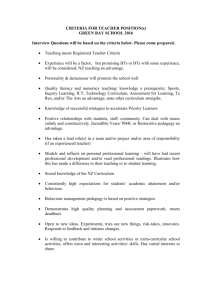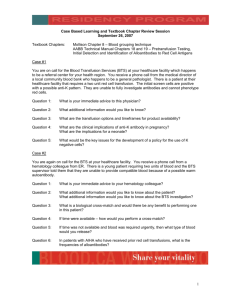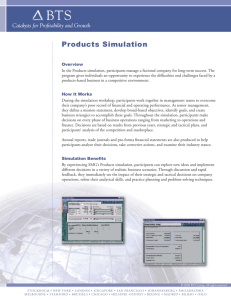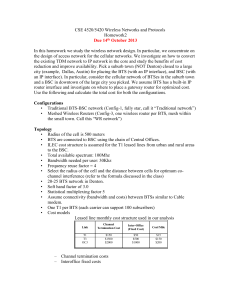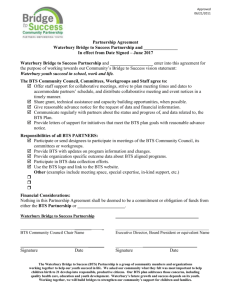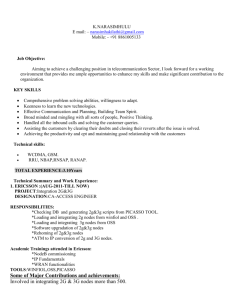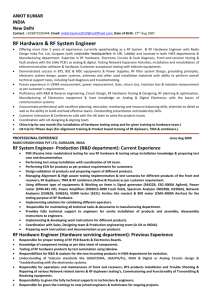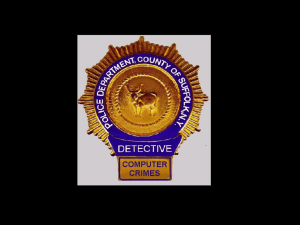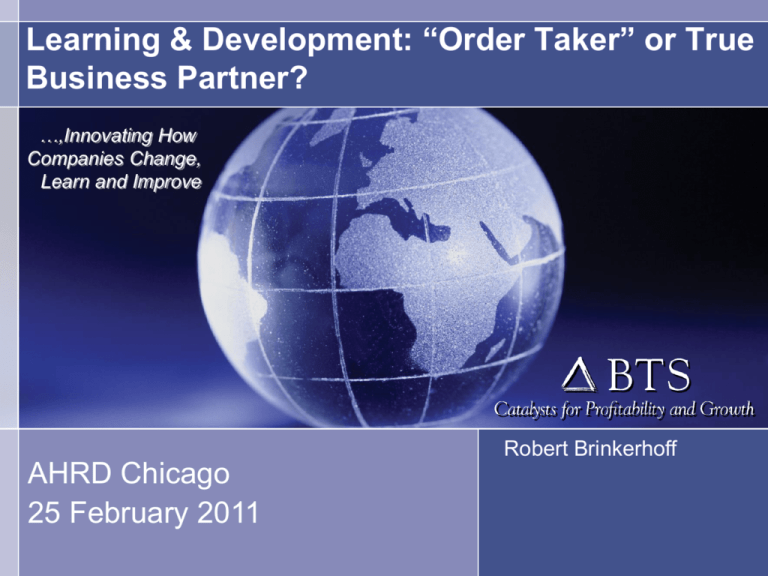
Learning & Development: “Order Taker” or True
Business Partner?
…,Innovating How
Companies Change,
Learn and Improve
Robert Brinkerhoff
AHRD Chicago
25 February 2011
Partial List: Licensed Advantage Way Customers
•
•
•
•
•
•
•
•
•
•
•
•
•
•
•
•
3M
Agilent Technologies
American National Bank
Ameriprise Financial Services
Bank of America
Cargill
Catholic Health Partners
Catholic Health Initiatives
Cephalon
Children’s Healthcare of Atlanta
Clark County School District
Dell
Discover Financial Services
Energy Australia
Holcim
IBM
© BTS 2010
•
•
•
•
•
•
•
•
•
•
•
•
•
•
•
•
•
Insight Enterprises
Johnsonville Sausage
Kellogg’s
Kroger
Limited Brands
Nike
Novo Nordisk (Denmark)
Plastipak
Rice University
Salesforce.com
SPX
Symantec
Takeda Pharmaceutical
Trinity Health Care
Toyota Mfg.
University of Virginia Medical Center
Wrigley
Training: Benefit vs Business Driver
Training as a “Staff Benefit”
Expectation: Participate, Appreciate
Training as Business Driver
Expectation: Focus, Participate, Learn and Apply
© BTS 2010
© 2010 Robert Brinkerhoff & Advantage
Performance Group & BTS – all rights
reserved
The Proper Goal for Training
Not “Learning” or
“Competency” or “ROI”….
To make important
contributions to strategic
initiatives
© BTS 2010
The Proper - “Business” -Goal for Training
What are “important
contributions…?”
To Accelerate Execution of
Critical Strategic Change
© BTS 2010
Accelerating Change and Adoption
% ADOPTION
Accelerated rate of adoption
100%
Expected rate of adoption
50%
0
TIME
© BTS 2010
Two Realities of Training
Predictable Training Impact Distribution
> 15%
< 70% >
DID NOT TRY IT
AT ALL
TRIED IT TO SOME EXTENT BUT
GAVE UP
© BTS 2010
< 15%
TRIED IT AND
GOT POSITIVE
RESULTS
An Example
COSTS
?%
?%
DID NOT TRY IT
AT ALL
TRIED IT TO SOME EXTENT BUT
GAVE UP
90/100 did NOT use it or get results
Unrealized value = $4.5 million!
UNREALIZED VALUE
© BTS 2010
?%
TRIED IT AND
GOT POSITIVE
RESULTS
10/100
@$50,000
Total = $500,000
RETURN
Unrealized Value Example
Good news!
• People loved it ! Overall rating 4.8
• ROI = 200+%!
• Training for 300 people cost $900,000
• Usage of training led to >$1.8 million in new
income
© BTS 2010
Unrealized Value Example
Bad news…
• Only 60 of 300 got value (20%)
• What if 60 more used it just half as well?
© BTS 2010
Unrealized Value Example
Bad news…
• Only 60 of 300 got value (20%)
• What if 60 more used it just half as well?
• $900,000 more in value!
© BTS 2010
So What?
Is 15% - 20% Good Enough?
Value of More Managers Applying Training
[Value of one manager using training = $20,000]
Increasingly
more return
$10,000,000
$9,000,000
$8,000,000
$7,000,000
$6,000,000
$5,000,000
$4,000,000
$3,000,000
$2,000,000
$1,000,000
$0
Same
cost
Total
cost
© BTS 2010
$2k per manager
Expected Return
15%
rate
40%
rate
75%
rate
90%
rate
Lessons of Reality #1
• Aim to “Grow” Impact
• Measure and convert “Unrealized Value”
• ROI is driven by number of Trainees USING
learning
• The Mission:
Not to “Do Great Training ”
Instead:
Help your company get Great Results from Training
© BTS 2010
The Right Training Goal
COSTS
?%
?%
90%+
TRIED IT TO SOME EXTENT BUT
TRIED IT
AND
GAVE
UP GOT POSITIVE
RETURN
© BTS 2010
RESULTS
Failure Mode Analysis – Top Six causes?
“Before” Preparation and
Readiness
o
Senior leaders did not see how the
training could help the business and
failed to support it
o
Trainees were not motivated to
participate
o
Managers of trainees did not
understand how the training would
benefit them or their goals
o
Trainees did not see exactly how
they could use the training in their
work
o
Managers did not encourage
trainees to participate
© BTS 2010
“During” – Conduct
Learning Intervention
“After” – Support
Performance Improvement
o
Managers did not hold trainees accountable for
applying the learning
o
The incentives for continuing to follow existing
procedures were still attractive
o
The training facilitators did a bad job
o
The materials were not relevant to trainees
o
The measurement and feedback systems were
not sufficient to track new behaviors
o
The trainees were not capable of learning
the content
o
Trainees did not get good coaching in how best
to use the new behaviors they learned in training
o
The training materials were poorly
organized
o
o
The sessions were scheduled at
inconvenient times
Managers were pressured to keep top-line
revenues up and told trainees to just focus on
doing things the way they used to
High Impact Learning Process
Making Training Work
© BTS 2010
Impact of Training
“Before”
TE
“After”
Training “Event”
© BTS 2010
RESULTS
Results
Learning to Performance Process
Create Focus
& Build
Intentionality
Provide Quality
Learning
Interventions
Support
Performance
Improvement
Greatest Opportunities for
– Improvement
– Leverage
© BTS 2010
RESULTS
A New Model for Performance
Create Focus
& Build
Intentionality
Provide Quality
Learning
Interventions
Support
Performance
Improvement
RESULTS
Implementing this approach requires new actions from managers
Sustaining this approach is a whole organization accountability
– not just L&D’s accountability
© BTS 2010
Business Impact
© BTS 2010
Reality #2
Training alone is never the principal
cause of success or failure
• STOP evaluating “training”
• Evaluate how well your company uses
training to get results
• “Teach”: An organization cannot delegate
results to the “L&D Department”
Producing Results is a Wholeorganization Responsibility
© BTS 2010
The Anatomy of Training Impact:
When training works, what happens?
S
Individual or Team Job
S
Learning
Intervention
S
S
S
R
Business
Goal
S
S
Impact occurs when:
A training-acquired skill [S] is applied to improve performance in some part of a
that produces a Result [R] that contributes to a Business Goal
© BTS 2010
job
Implication
• Don’t seek “learning transfer”
• Seek “Leveraged Application”
© BTS 2010
The Advantage WaySM Process Overview
Clarify Overall
Business Goal
Linkage
Educate and
Motivate Managers
Facilitate Impact Map
Dialogue Between
Managers & Learners
Prepare Facilitators to
Leverage Impact
Maps During Program
CONDUCT LEARNING PROGRAM
Engage Learners
in Impact Map
Reflection
Learners Identify
On-job Learning
Application Obstacles
Learners Prepare
Action Plan (based on
Impact map)
ALL
Help Manager
Understand and Plan
to Address
Performance
Obstacles
Manager & Learner
Discuss Action Plan
and Set Objectives
Managers Provide
Ongoing Coaching
and Support
Other
Resources
© BTS 2010
Measure
Effectiveness
and Impact With
Success Case
Study
Key Evaluation Questions
•Who used the training, how, when and
where?
•When the training was used, what good did
it do?
•When it was not used, why not?
•When it worked, why? Who did what?
•What needs to be done to get improved
results?
© BTS 2010
Success Case Evaluation Method® Findings
High Impact Learning
Resource Used
Manager completed the
impact booster session
Trainee and Manager
met and completed an
impact map
Trainee and manager
met after training to
agree on an action plan
© BTS 2010
Number and
percentage
60 Highest
Impact Trainees
60 Lowest
Impact Trainees
(Total = 300)
(top 20%)
(bottom 20%)
Value: $20,000
Value: - $1,500
294
58
60
(98%)
(97%)
(100%)
195
55
12
(60%)
(91%)
(20%)
120
52
4
(40%)
(86%)
(7%)
Summary Challenge
•How make the execution process (change)
work faster?
•How measure acceleration?
•How do L&D Leaders lead the process?
•How do we create a “Learning Capable”
organization that can:
Out-learn in order to Out-execute
competitors?
© BTS 2010
NEW BOOK!
Published by
Berrett-Koehler
www.amazon.com
© BTS 2010

